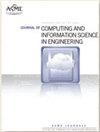Unsupervised Anomaly Detection via Nonlinear Manifold Learning
IF 2.6
3区 工程技术
Q2 COMPUTER SCIENCE, INTERDISCIPLINARY APPLICATIONS
Journal of Computing and Information Science in Engineering
Pub Date : 2023-10-04
DOI:10.1115/1.4063642
引用次数: 0
Abstract
Abstract Anomalies are samples that significantly deviate from the rest of the data and their detection plays a major role in building machine learning models that can be reliably used in applications such as data-driven design and novelty detection. The majority of existing anomaly detection methods either are exclusively developed for (semi) supervised settings, or provide poor performance in unsupervised applications where there is no training data with labeled anomalous samples. To bridge this research gap, we introduce a robust, efficient, and interpretable methodology based on nonlinear manifold learning to detect anomalies in unsupervised settings. The essence of our approach is to learn a low-dimensional and interpretable latent representation (aka manifold) for all the data points such that normal samples are automatically clustered together and hence can be easily and robustly identified. We learn this low-dimensional manifold by designing a learning algorithm that leverages either a latent map Gaussian process (LMGP) or a deep autoencoder (AE). Our LMGP-based approach, in particular, provides a probabilistic perspective on the learning task and is ideal for high-dimensional applications with scarce data. We demonstrate the superior performance of our approach over existing technologies via multiple analytic examples and real-world datasets.基于非线性流形学习的无监督异常检测
异常是与其他数据明显偏离的样本,它们的检测在构建机器学习模型中起着重要作用,这些模型可以可靠地用于数据驱动设计和新颖性检测等应用。大多数现有的异常检测方法要么是专门为(半)监督设置开发的,要么在没有标记异常样本的训练数据的无监督应用中提供较差的性能。为了弥补这一研究差距,我们引入了一种基于非线性流形学习的鲁棒、高效和可解释的方法来检测无监督设置中的异常。我们的方法的本质是学习所有数据点的低维和可解释的潜在表示(又名流形),以便正常样本自动聚类在一起,从而可以轻松且稳健地识别。我们通过设计一种学习算法来学习这种低维流形,该算法利用了潜在映射高斯过程(LMGP)或深度自动编码器(AE)。特别是,我们基于lmpp的方法提供了学习任务的概率视角,非常适合具有稀缺数据的高维应用程序。我们通过多个分析示例和真实世界的数据集证明了我们的方法优于现有技术的性能。
本文章由计算机程序翻译,如有差异,请以英文原文为准。
求助全文
约1分钟内获得全文
求助全文
来源期刊
CiteScore
6.30
自引率
12.90%
发文量
100
审稿时长
6 months
期刊介绍:
The ASME Journal of Computing and Information Science in Engineering (JCISE) publishes articles related to Algorithms, Computational Methods, Computing Infrastructure, Computer-Interpretable Representations, Human-Computer Interfaces, Information Science, and/or System Architectures that aim to improve some aspect of product and system lifecycle (e.g., design, manufacturing, operation, maintenance, disposal, recycling etc.). Applications considered in JCISE manuscripts should be relevant to the mechanical engineering discipline. Papers can be focused on fundamental research leading to new methods, or adaptation of existing methods for new applications.
Scope: Advanced Computing Infrastructure; Artificial Intelligence; Big Data and Analytics; Collaborative Design; Computer Aided Design; Computer Aided Engineering; Computer Aided Manufacturing; Computational Foundations for Additive Manufacturing; Computational Foundations for Engineering Optimization; Computational Geometry; Computational Metrology; Computational Synthesis; Conceptual Design; Cybermanufacturing; Cyber Physical Security for Factories; Cyber Physical System Design and Operation; Data-Driven Engineering Applications; Engineering Informatics; Geometric Reasoning; GPU Computing for Design and Manufacturing; Human Computer Interfaces/Interactions; Industrial Internet of Things; Knowledge Engineering; Information Management; Inverse Methods for Engineering Applications; Machine Learning for Engineering Applications; Manufacturing Planning; Manufacturing Automation; Model-based Systems Engineering; Multiphysics Modeling and Simulation; Multiscale Modeling and Simulation; Multidisciplinary Optimization; Physics-Based Simulations; Process Modeling for Engineering Applications; Qualification, Verification and Validation of Computational Models; Symbolic Computing for Engineering Applications; Tolerance Modeling; Topology and Shape Optimization; Virtual and Augmented Reality Environments; Virtual Prototyping

 求助内容:
求助内容: 应助结果提醒方式:
应助结果提醒方式:


